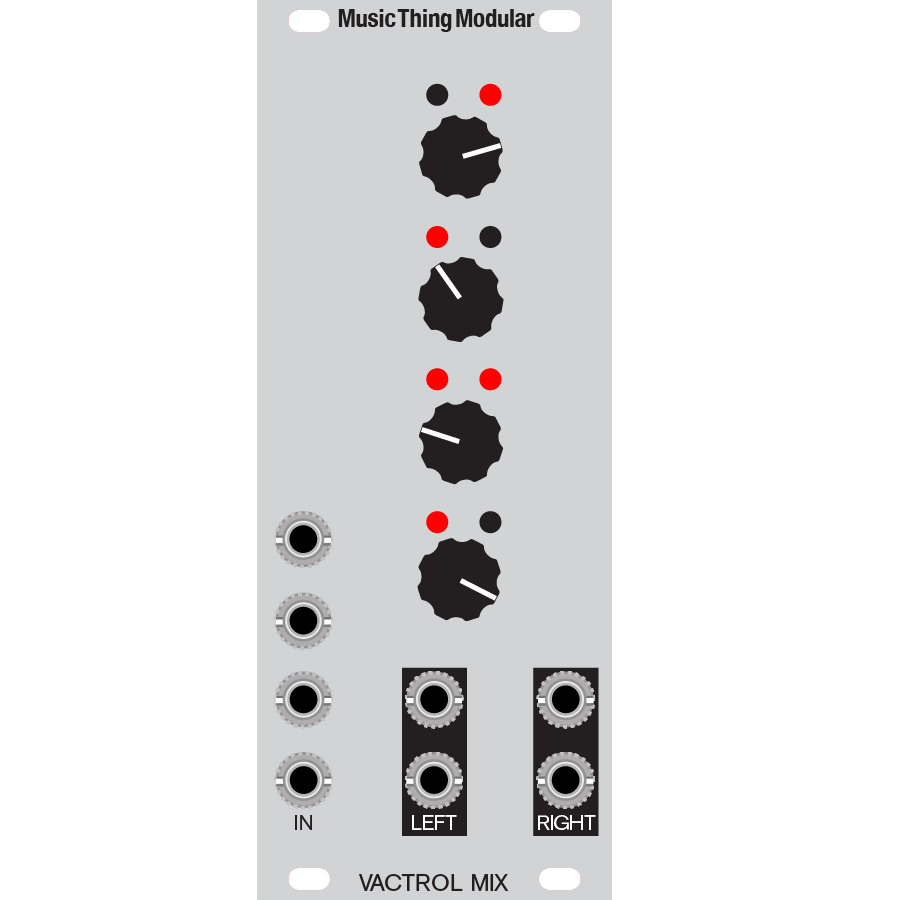11 things to know about Turing: Vactrol Mix

10 HP |
30mm deep |
40mA
Designed March 2015
Modular Grid |
Videos
Github |
Schematic
- Sadly Vactrol Mix is no longer available for sale. RoHS regulations in UK/EU mean we can't sell vactrols, which contain cadmium.
- This expander is 4 in, 2 out vactrol matrix mixer controlled by the Turing Machine, connected around the back by a 16 pin ribbon cable.
- There are four inputs, for audio or CV sources. The four knobs set the level for each input. Next to each knob is a pair of LEDs. When the LED on the left is lit, the signal goes to the left output. When the LED on the right is lit, the signal goes to the right output. The LEDs are controlled by the Turing Machine module. The two outputs are both doubled (mult-ed) to make it easier to patch feedback loops.
- Despite being less popular or widespread than Pulses or Volts, this is my favourite Turing Machine expander. It is a unique device that turns mundane source material into wild, unpredictable but rhythmically accessible patterns of sound. It’s a great way to create stereo effects, shifting drones, complex waveforms or feedback loops, and can be the heart of small (but chaotic) system.
- Vactrols are electro-optical devices; a light shining on a light-dependent resistor. They have an extraordinary history, from powering the optical soundtracks on the first sound films in the 1920s to studio compressors, the tremolo in Fender guitar amps, and many of Don Buchla's 1970s synth designs. Modern vactrols are an LED pointing at a cadmium light dependent resistor, sealed together in a little black plastic box. Because the LDR reacts relatively slowly, the signals cut together smoothly, with no clicks or pops. Unfortunately, the cadmium in light dependent resistors is banned in Europe, so Vactrols are becoming harder to find.
- Feedback is where this module gets really interesting. Try sending the (bottom) left and right outputs to your output mixer, and the (top) left and right outputs to spring reverbs or delays, patching the delay/reverb outputs back into input channels. Carefully ride the input levels, and you'll get snippets of feedback. The main clock speed can have a huge effect on feedback levels, because it takes a while to build up.
- There are lots of Vactrol Mix audio examples in my Soundcloud: Twenty Minutes of Madness, Contact Mic Feedback and this ancient track recorded using the breadboard prototype.
- The Vactrol Mix is DC coupled, so you can also rhythmically cut up DC sources; mix LFOs at different speeds with audio rate oscilllators, and frequency modulating a pair of oscillators using the two outputs.
- This module was inspired by Grant Richter's Cadavre Exquis voltage controlled mixer, which was inspired by André Breton's surrealist game Exquisite Corpse. Richter's mixer also inspired the RxMx module by Make Noise.
- Jonathan Higgins, on Facebook: 'There isn't a patch I don't use it on. People often thing you can only use it for crazy stereo percussion (which it is amazing at). But I also often patch all four outputs from the humpback filter into it for evolving stereo drones.'
- The Vactrol Mix is a very straightforward through-hole DIY build. If you get stuck, the Github Issue List is probably the best place to start - remember to check closed issues as well as open ones.
Mylar Melodies Ten Years of Turing
DivKid explains the Turing Machine & expanders
Mega Turing workout from Mylar Melodies
